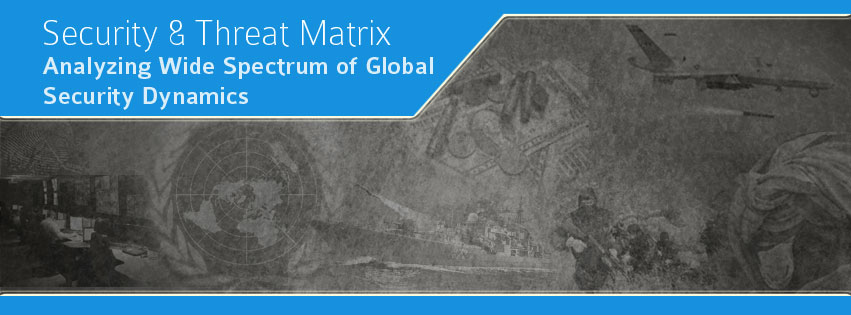By Tariq Niaz
The supreme art of war is to subdue the enemy without
fighting. This Sun Tzu philosophy should have been the key to take on the combined
Arab Afghan tribal militancy instead after 9/11 US led allies preferred use of
lethal force. It is almost five years now that Osama Bin Laden was killed in a
US raid in Abbottabad. In its immediate aftermath there have been many more killings
of Al-Qaeda’s key field commander considered number three and four in the ranking
i.e. Abu Yahya Al-Libi and Attiya Abdur Rahman al Libi. After Osama, Dr. Ayman
Al Zawahiri the then number two came up as an obvious choice to lead Al-Qaeda which
also initiated its transition from Arab to an Egyptian Akhwan dominated one. This
change of leadership had drastic political and financial impact on the
organization which was once flag bearer of militancy in the region.
Osama trusted lieutenants used to be from Libya, Yemen Syria
or Iraq and very few from Egypt. This Arab dominance was instrumental in creating
massive appeal for funding and recruitment amongst tribal Arabs. Due to his
Egyptian background, Dr Zawahiri failed to maintain this support base. Gradual
loosening of command and control provided space to Abu Bakr al Baghdadi’s Islamic
State of Iraq and Syria (ISIS) which not only moved the center of struggle from
Khorasan to the valley of two rivers but also took over effective control of flow
of funds emanating from private sources in the entire Arab world. ISIS kept
pace with emerging requirements of Sunni Salfi ideology and focused its war on
near enemy against Al-Qaeda approach of far enemy first. Due to Pakistan Army
operation in the lawless FATA and US sustained drone campaign in both
Afghanistan and Pakistan strength of Pakistani Taliban was decimated. During
2014, Zawahiri announced formation of another franchise Al-Qaeda in Indian subcontinent
(AQIS), an effort to spread militancy in Pakistan, India and beyond from the
port city of Karachi.
Formation of this new franchise raised many questions. Was Al-Qaeda
shifting its focus from Afghanistan and Iran to Pakistan, India and beyond thus
leaving its Afghan stronghold to ISIS? Had it purposely or under duress surrendered
Khorasan to the ISIS thus facilitating encirclement of Iran? Was Al-Qaeda
trying to establish itself in settled areas where availability of organized
militant networks can be more useful to its future global designs? All question
aside, the latest Al-Qaeda move of concentrating in mega city like Karachi can
have dreadful implications for the entire South Asia in general and Karachi in particular.
Al-Qaeda appeal to youth was centered on its ideology of
following pious ancestors (Salaf) and establishing Islamic Caliphate to enforce
Sharia. That seems intact especially in settled areas of Pakistan where it targets
educated youths to fill its ranks. The two terror incidents of Parade Lane at
Rawalpindi and Safoora Goth in Karachi in which the facilitators were mostly
from educated families vindicate the assertion. The facilitator network in
Islamabad and Karachi played an effective role for the foot soldiers brought from
FATA to conduct the killings. Karachi, due to ineffective policing, governance
issues, political rivalries and social division on ethnic, linguistic and
sectarian lines has turned into a lawless paradise for criminals. AQIS is fast
gaining grounds in Karachi thanks largely to its vast network of Madrassas and
sympathizers. Local Al-Qaeda leadership is not to be seen in prominence but
foot soldiers of their affiliate are active in target killings, abduction and
ransom crimes. AQIS ranks will soon be battle hardened to undertake larger Trans
frontier operations. Where Al-Qaeda would
strike next and what it aims to do in South Asia especially in the backdrop of
worsening Pak-India relations is a question likely to bring nightmares to the counter-terrorism experts.
Can Al-Qaeda do this alone or it will team up
with local militant organizations like Lashkar e Jhangvi or Urban Taliban
networks will be interesting to watch in the near future. Urban Karachi provide
wide choice to Al-Qaeda to penetrate
nontraditional recruitment grounds including Mohajir, Bengali and other
immigrants communities to fight for the enforcement of sharia. AQIS presence is
like an umbrella and its alliance with the local militant groups is evident
from the rising intensity in target killing, abduction and ransom crimes in Karachi.
AQIS major operation in the city was its attempted hijacking of Pakistani Navy
vessel from the port of Karachi in September 2014. Recent upsurge in target
killing, abduction and ransom crimes indicate that Al-Qaeda alliance with the
local militant organization and criminal gangs is complete. AQIS is likely
raise crimes intensity systematically and a particular sectarian group will be
targeted in Karachi to draw both Sunni and Shia against each other. This is
start of a bigger terror campaign with possible targets outside Pakistani
borders in the near future to destroy the regional peace and harmony. About Author:
Author is a freelance writer. He gained firsthand experience in security and counterterrorism and is expert in this domain with years of professional experience. He mostly writes about security issues and counter terrorism challenges posed to the state of Pakistan. He can be reached at niaz_tariq@yahoo.com





No comments:
Post a Comment